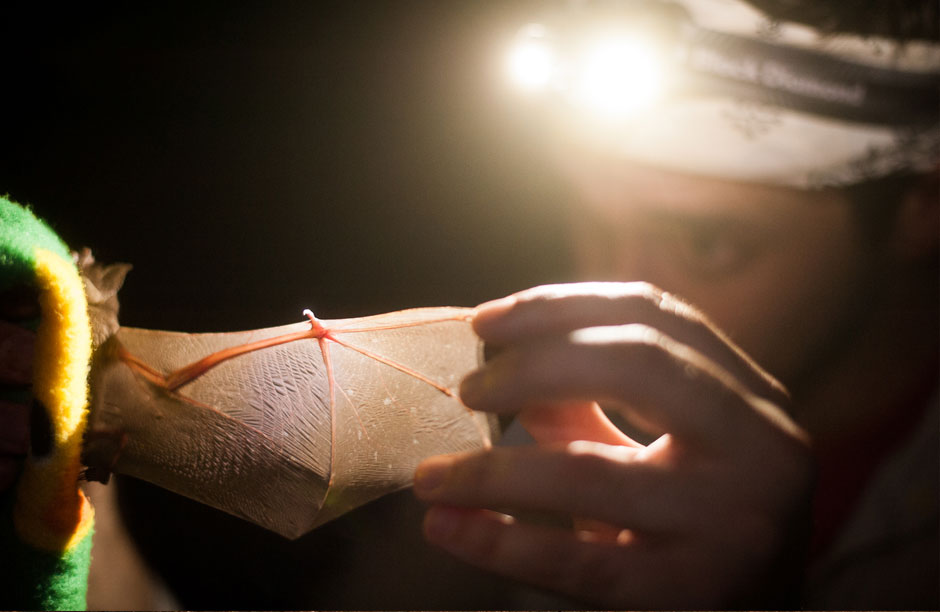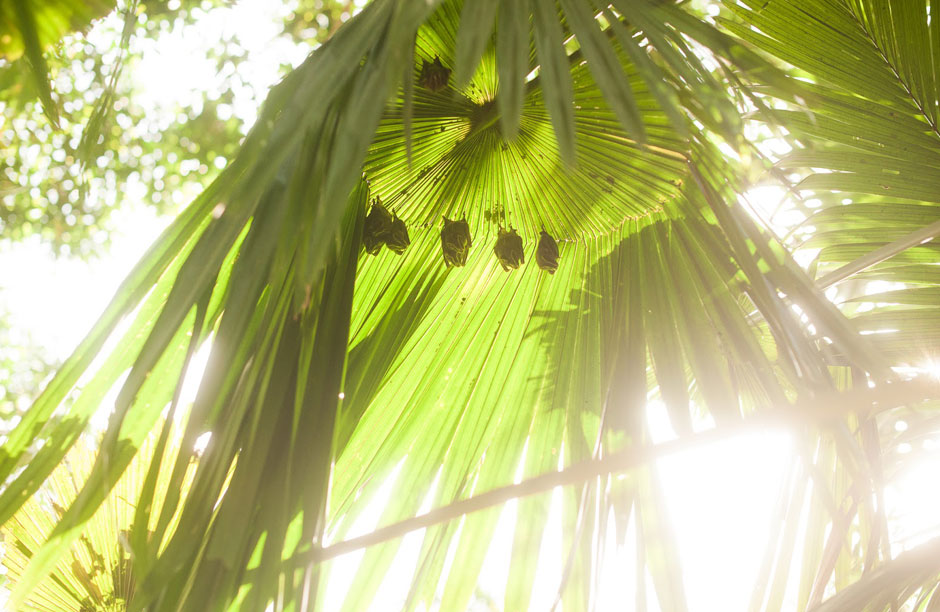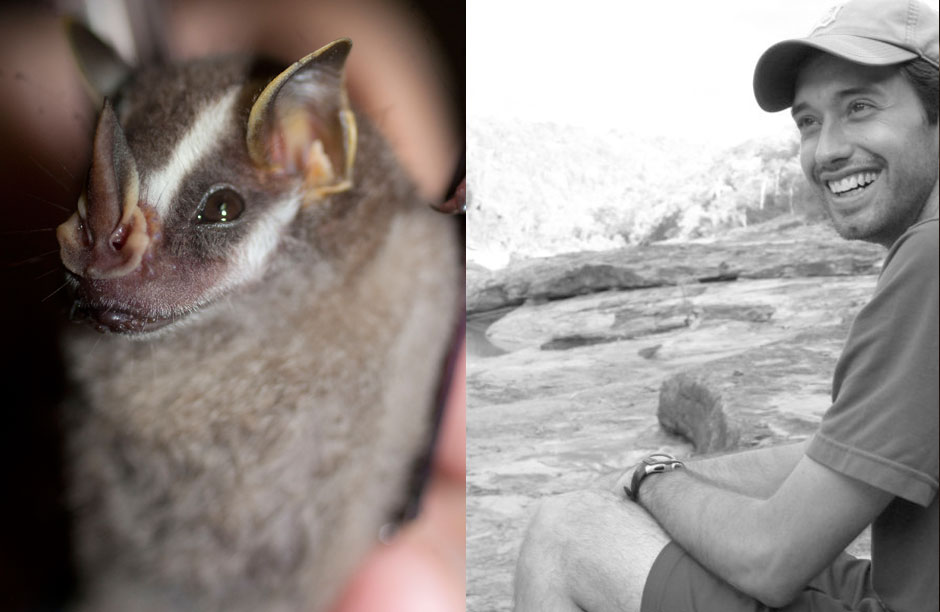PAST ISSUES
 Research Biologist Teague O’ Mara holds out the wing of a Tent Making Bat while out in the field in Panama. The bat’s wing anatomically resembles a human hand. Photo by: Alex Tran
Research Biologist Teague O’ Mara holds out the wing of a Tent Making Bat while out in the field in Panama. The bat’s wing anatomically resembles a human hand. Photo by: Alex Tran The “Tent Making Bats” construct “tents” out of large, fan-shaped palm leaves by severing the midribs of the leaves, and as a result, the leaves collapse and the whole structure becomes a water-resistant, sunshade teepee. The tent is occupied by a single, or occasionally two, adult males and their “harem” of 5 to 10 females.
The “Tent Making Bats” construct “tents” out of large, fan-shaped palm leaves by severing the midribs of the leaves, and as a result, the leaves collapse and the whole structure becomes a water-resistant, sunshade teepee. The tent is occupied by a single, or occasionally two, adult males and their “harem” of 5 to 10 females. Image Left: Portrait of an Uroderma bilobatum also known as the “Tent Making Bat”. Image Right: Research Biologist Teague O’ Mara has been a resident biologist at the Smithsonian Tropical Research Institute in Panama for the past 3 years.
Image Left: Portrait of an Uroderma bilobatum also known as the “Tent Making Bat”. Image Right: Research Biologist Teague O’ Mara has been a resident biologist at the Smithsonian Tropical Research Institute in Panama for the past 3 years.
A Night in The Life of a Scientist in the Field
By Vanessa BoshoffAlong the earth’s equator where biodiversity is at its peak scientists have always flocked. In Panama’s equatorial jungles a community of scientists have created their own “district” centered around The Smithsonian Tropical Research Institute. The Institute attracts over 900 research scientists each year from all over the world. Environmental reporter and activist Vanessa Boshoff spends an evening out in the field with one of the Smithsonian’s resident biologist’s, Teague O’ Mara, and learns that the life of a biologist is often dictated by the lifestyle and habits of the animals they are studying.
The sun is setting over the lush Panama Canal. The howler monkeys hoot in the nearby jungle heralding the green parrots to their roost, as the clouds burn amber to close on another beautiful day in paradise. On most days I would be ready for a “sundowner” on the porch, but tonight I am starting off with a breathalyzer.
“Here, hold this.” Teague O’Mara, Ph.D., hands me a gently gauzed package about the size of an apricot. The little heartbeat is fluttering against my hand — the big black eyes staring straight into me. I place the warm body into a clear box — about the size of a Kleenex box — and Teague seals the lid tightly. “Now we just let in this air that has been scrubbed of any carbon dioxide, and whatever he breathes out, that is the air we can test for carbons that will tell us what he has been eating, who he has been hanging out with, and even where he has been going.”
Just then, O’Mara sucks out the “exhaled” air into another sealed container that he will test back at the lab. It is a quick process, and I am shocked that we can learn so much about this tiny creature just from his breath.
O’Mara unwraps the gauze ever so tenderly, and the little paper-thin wings unfold revealing the full body of the Uroderma bilobatum, commonly known as the tent-making bat. With extremely elongated fingers and a wing membrane stretched between, the bat’s wing anatomically resembles a human hand. It is a sweet looking creature, with an upturned nose and fluffy hair striped with pale white running down the middle of its back. The shape of their faces has been related to their diet, as the upturned nose makes it more comfortable to carry a piece of fruit (almost the size of their body) to a night roost to eat it. Here in Panama, the tent-making bats are important seed dispersers, which help keep the ecosystem of the forest healthy and growing.
O’Mara has been studying these bats in Panama with the Smithsonian Tropical Research Institute for the last 3 years. His focus is on the importance of socialization of the bats and what happens when the social structure is stressed or compromised. It seems strange to focus on such a small animal, but in fact, bats make up a quarter of all mammal species on Earth and are the only mammals capable of true flight.
“The tent-making bat is a great study, as their social groups are very important to the survival of their species,” says O’Mara. “They rely on each other for grooming, helping find the best food and even babysitting.” He starts unwrapping a black tangle of baby hair–thin net. “This is the net we will put up in the fig tree to try and catch a few specimens. The net is thin enough that if the bat is caught for too long he can easily chew through it, and if it is flying fast enough, it will just break through. All of our work pretty much has to be done after sunset, when the bats are active.”
O’Mara himself has changed his social life to match the bats as well. He sleeps in the day and heads out to work in the hot tropical jungle after dark, armed with tagging devices, mist nets, cages, and infrared lights. Every evening around 7 pm, the bats leave their tents in search of their favorite food, figs. This is when O’Mara starts his day. He stakes out the bats’ favorite fig tree, his net in place, ready to work through the night. He then captures a few bats to implant with a tracking device so he can follow the bats’ behaviors from a radar. It’s a waiting game, as the bats are active in periods throughout the night. O’Mara has set up several stations around the area where he can check on the bats via radar and infrared lights, but some nights the torrential tropical rainstorms make this a difficult task.
Tent-making bats are named that because that is exactly what they do. They construct “tents” out of large, fan-shaped palm leaves by severing the midribs of the leaves, and as a result, the leaves collapse and the whole structure becomes a water-resistant, sunshade teepee. The tent is occupied by a single adult male, or occasionally two, and a “harem” of 5 to 10 females.
“The structural ingenuity of the tent plus its sophisticated repair suggests a complex bat behavior,” O’Mara explains. “These bats are really social; they bicker and talk, and even form cliques of certain popular females within the group. People don’t think of bats as having a social life, but our studies have proven that it is a very important part of bat life. If a bat is rejected, or someone dies in the group, the bats get stressed, their cortisol levels rise, and that is dangerous, just like in humans, and can even be fatal. We are learning that it is important for the bats to keep a social balance to be happy and have a well-adjusted home life.
“What we have found to be most interesting is their social communication, known as contact calls. Tent-making bats are an excellent model for studying the evolution of contact calling and how they use it to alert the others where food is, where danger may be, and also may be associated with family recruitment. The male and also his dominant female seemed to be instigating the calls. Calling often ended once all the bats arrived back at the tent, suggesting that calls may be involved in making sure the group was complete, home safe and sound before the sunrise.”
O’Mara has been studying socialization in mammals for years; he started out in the field working with the lemurs in Madagascar. “It is hard not to compare the social antics of mammals to people, as we share a lot of the same characteristics. Primates especially, but now that I have been with the bats, I also see a lot of personality in them. In all these species, I found that they enjoy and actually need a social life to sustain their own.”
As for O’Mara, the many scientists that frequent this part of Panama keep his social life active and balanced. In fact, Barro Colorado, the Smithsonian’s Panamanian research island, is the most studied place on the planet. The Smithsonian Tropical Research Institute (STRI) is a hub for scientists dedicated to understanding biological diversity.
What began in 1923 as a small field station on the Panama Canal Zone has developed into one of the leading research institutions in the world. STRI’s facilities provide a unique opportunity for long-term ecological studies in the tropics, and are used extensively by some 900 scientists from around the world every year. Luckily, a lot of the scientists studying here are also working with nocturnal creatures, so the dark jungle at night is not so lonely for a bat scientist such as O’Mara.
